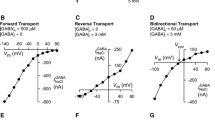Abstract
Squid giant axons recover from acid loads by activating a Na+-driven Cl–HCO3 exchanger. We internally dialyzed axons to an intracellular pH (pH i ) of 6.7, halted dialysis and monitored the pH i recovery (increase) in the presence of ATP or other nucleotides, using cyanide to block oxidative phosphorylation. We computed the equivalent acid-extrusion rate (J H) from the rate of pH i increase and intracellular buffering power. In experimental series 1, we used dialysis to vary [ATP] i , finding that Michaelis-Menten kinetics describes J H vs. [ATP] i , with an apparent V max of 15.6 pmole cm−2 s−1 and K m of 124 μM. In series 2, we examined ATPγS, AMP-PNP, AMP-PCP, AMP-CPP, GMP-PNP, ADP, ADPβS and GDPβS to determine if any, by themselves, could support transport. Only ATPγS (8 mM) supported acid extrusion; ATPγS also supported the HCO −3 -dependent 36Cl efflux expected of a Na+-driven Cl–HCO3 exchanger. Finally, in series 3, we asked whether any nucleotide could alter J H in the presence of a background [ATP] i of ∼230 μM (control J H = 11.7 pmol cm−2 s−1). We found J H was decreased modestly by 8 mM AMP-PNP (J H = 8.0 pmol cm−2 s−1) but increased modestly by 1 mM ADPβS (J H = 16.0 pmol cm−2 s−1). We suggest that ATPγS leads to stable phosphorylation of the transporter or an essential activator.




Similar content being viewed by others
References
Altamirano AA, Breitwieser GE, Russell JM (1988) Vanadate and fluoride effects on Na+-K+-Cl− cotransport in squid giant axon. Am J Physiol 254:C582–C586
Altamirano AA, Breitwieser GE, Russell JM (1995) Effects of okadaic acid and intracellular Cl− on Na+-K+-Cl− cotransport. Am J Physiol 269:C878–C883
Beauge L, Di Polo R (1981) The effects of ATP on the interactions between monovalent cations and the sodium pump in dialysed squid axons. J Physiol 314:457–480
Boron WF (1985) Intracellular-pH-regulating mechanism of the squid axon: relation between the external Na+ and HCO −3 dependences. J Gen Physiol 85:325–345
Boron WF (1989) Cellular buffering and intracellular pH. In: The regulation of acid-base balance. Raven Press, New York, pp 33–56
Boron WF, De Weer P (1976a) Active proton transport stimulated by CO2/HCO −3 blocked by cyanide. Nature 259:240–241
Boron WF, De Weer P (1976b) Intracellular pH transients in squid giant axons caused by CO2, NH3 and metabolic inhibitors. J Gen Physiol 67:91–112
Boron WF, Hogan E, Russell JM (1988) pH-sensitive activation of the intracellular-pH regulation system in squid axons by ATP-g-S. Nature 332:262–265
Boron WF, Knakal RC (1985) Intracellular-pH regulation by the squid axon: competition of DNDS, a reversible stilbene derivative, with external Na+ and HCO −3 . Biophys J 47:490a
Boron WF, Knakal RC (1989) Intracellular pH-regulating mechanism of the squid axon: interaction between DNDS and extracellular Na+ and HCO −3 . J Gen Physiol 93:123–150
Boron WF, Russell JM (1983) Stoichiometry and ion dependencies of the intracellular-pH-regulating mechanism in squid giant axons. J Gen Physiol 81:373–399
Brinley FJ Jr, Mullins LJ (1967) Sodium extrusion by internally dialyzed squid axons. J Gen Physiol 50:2303–2331
Cassel D, Glaser L (1982) Resistance to phosphatase of thiophosphorylated epidermal growth factor receptor in A431 membranes. Proc Natl Acad Sci USA 79:2231–2235
Di Polo R (1977) Characterization of the ATP-dependent calcium efflux in dialyzed squid giant axons. J Gen Physiol 69:795–813
Gunderson KL, Kopito RR (1994) Effects of pyrophosphate and nucleotide analogs suggest a role for ATP hydrolysis in cystic fibrosis transmembrane regulator channel gating. J Biol Chem 269:19349–19353
Hinke JAM (1967) Cation-selective microelectrodes for intracellular use. In: Glass electrodes for hydrogen and other cations. Principle and Practice. Dekker, New York, pp 464–477
Hwang TC, Nagel G, Nairn AC, Gadsby DC (1994) Regulation of the gating of cystic fibrosis transmembrane conductance regulator Cl channels by phosphorylation and ATP hydrolysis. Proc Natl Acad Sci USA 91:4698–4702
Lienhard GE, Secemski II (1973) P1,P5-di(adenosine-5′)pentaphosphate, a potent multisubstrate inhibitor of adenylate kinase. J Biol Chem 248:1121–1123
Roos A, Boron WF (1981) Intracellular pH. Physiol Rev 61:296–434
Russell JM, Boron WF (1976) Role of chloride transport in regulation of intracellular pH. Nature 264:73–74
Thevenod F, Anderie I, Schulz I (1994) Monoclonal antibodies against MDR1 P-glycoprotein inhibit chloride conductance and label a 65-kDa protein in pancreatic zymogen granule membranes. J Biol Chem 269:24410–24417
Thomas RC (1976) Ionic mechanism of the H+ pump in a snail neurone. Nature 262:54–55
Thomas RC (1977) The role of bicarbonate, chloride and sodium ions in the regulation of intracellular pH in snail neurones. J Physiol 273:317–338
Virkki LV, Choi I, Davis BA, Boron WF (2003) Cloning of a Na+-driven Cl/HCO3 exchanger from squid giant fiber lobe. Am J Physiol 285:C771–C780
Wu JV, Joo NS, Krouse ME, Wine JJ (2001) Cystic fibrosis transmembrane conductance regulator gating requires cytosolic electrolytes. J Biol Chem 276:6473–6478
Young LH, Li J, Baron SJ, Russell RR (2005) AMP-activated protein kinase: a key stress signaling pathway in the heart. Trends Cardiovasc Med 15:110–118
Acknowledgments
This work was supported by National Institutes of Health grants NS18400 and NS11946. We thank Mr. Mike Hernandez for assistance in performing the ATP assays and Mr. Duncan Wong for technical assistance.
Author information
Authors and Affiliations
Corresponding author
Rights and permissions
About this article
Cite this article
Davis, B.A., Hogan, E.M., Russell, J.M. et al. ATP Dependence of Na+-Driven Cl–HCO3 Exchange in Squid Axons. J Membrane Biol 222, 107–113 (2008). https://doi.org/10.1007/s00232-008-9100-1
Received:
Accepted:
Published:
Issue Date:
DOI: https://doi.org/10.1007/s00232-008-9100-1




